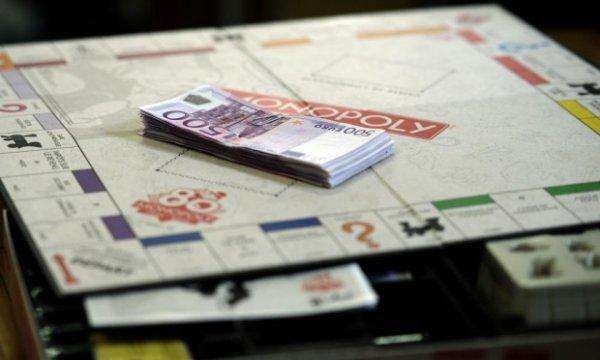Here’s you play Beijing’s new signage regulations, (loosely) inspired by Monopoly
Beijing’s Haidian district announced yesterday that has halted its part in the citywide mass campaign to remove signs from the tops and sides of buildings, due to the cold weather making such projects risky and people losing their way sans signs.
Since the end of November, almost 9000 of a planned 27,000 identifying characters, logos, and plaques have been removed from atop buildings in an effort to “illuminate Beijing’s skyline.” Complaints from a confused public recently led a People’s Daily editorial to ask: “Beijing’s removal of promotional signs: Is it too indiscriminate?” Their answer—are you holding your breath?—is that “the clean-up has a legal basis” in the “Beijing Municipal Plaque and Logo Set-up Management Standards,” which were updated on September 30.

Now, we at TWOC always stick to the letter of the law, but those regulations are eight pages long. Surely there’s a much better way to familiarize oneself with the plans that People’s Daily calls “words from the hearts of all who love Beijing?”
Therefore, we hereby present Signs and Ladders. Just as Risk is really Game Theory in disguise, and Monopoly taught countless generations the perils of rent-seeking, Signs and Ladders* help communicate an important message to would-be signage lovers out there, while providing fun for the whole family!
*Deluxe edition features 15 additional penalties not in the original, two new tokens—the Sledgehammer and the Thug—and your own cut-out-and-keep Beijing Municipal Plaque Standards-approved sign.
How to play
- 1. The board is set up like Monopoly: Each square represents a type of property, and landing on it means you’re trying to build a sign on it. Squares are grouped into four street types, each of a different width
- 2. Roll the dice and collect a card telling you what type of property you’ve landed on: Office building (dimensions, stories, and number of entrances are noted on the card) or single-story “time-honored brand” business. The cards also state the design of the entrance level of your building: columns or a recessed ground floor (known as qilou), an awning at the entrance, single-story building with a sloped roof, and entrances with no flat surface above or beside that can accommodate a sign. The height and width of the entrance are stated; if the building has columns, the width between the columns is stated
- 3. In addition to the property card, each player draws a Chance card, specifying what kind of sign they wish to build. The card contains information about the thickness of the characters, what kind of typeface it uses, the length of the sign, whether it’s stuck flat to the wall or hung, and where on the building you tried to build it
- 4. In lieu of Jail, there’s a square called “Restricted Area.” Signs in restricted areas cannot protrude from the surface at all
- 5. As each player makes their way around the board, they may move into buildings that have existing occupants, and try to erect a new sign there
- 6. Each player starts the game with 100 tokens which they lose when they violate the following rules (players can also make up their own penalties: such as drink, lose property,what have you, but no Monopoly money can be levied, since no one has been fined or compensated for the sign removals yet)

Rules
- 1. Buildings can only have as many signs as entrances, though they may have multiple plaques at one entrance for additional tenants. If you land on a square that already has the maximum number of signs, you lose tokens.
- 2. You lose tokens if you:
- 1. Land in the restricted area, automatically, since the actual policy doesn’t specify where restricted areas are
- 2. Build a sign on a building with multiple entrances and the length, width, or typeface of your sign doesn’t match your fellow tenants’
- 3. Build a sign that is longer than is allowed for your street width (see below)
- 4. Build a sign longer than the width of the building entrance
- 5. Build a sign longer than two-thirds of the width of the wall it’s on
- 6. Build a sign longer than the two-thirds of the width between columns on a qilou
- 7. Build a sign that’s longer than is allowed for the number of floors in your building (1.5 meters for 18 stories and below, 2 meters for above 19 stories)
- 8. Build a ground-floor sign that’s not at least 2.5 meters above ground level and less than 1.5 meters below the window of the next floor up
- 3. Here are the rules for sign-length by street:
| Width of street | Maximum length of sign |
| 16 meters or less | 0.5 meters |
| 16 to 24 meters (inclusive) | 0.6 meters |
| 24 to 40 meters | 0.7 meters |
| over 40 meters | 0.8 meters |
- 4. In the deluxe edition, every time the player rolls a multiple of four, the player draws a Property Chest card that specifies another rule violation not covered above, each of which gets another of their tokens taken away. These include:
- 1. Your stuck-on sign protrudes more than 0.3 meters from the wall (ignore if sign you drew is not a stick-on sign)
- 2. Your hung sign is not at right angles with the building, or is lower than the first-story (ignore if you did not draw a hung sign)
- 3. You’ve built an upright sign above the roof
- 4. You’ve built a sign under the eaves but a part of it is taller than the roof
- 5. You’ve built an upright sign above the podium
- 6. You’ve built a sign on the column of a qilou
- 7. You’ve put a sign outside a glass window, and/or it blocks light to that window
- 8. You’ve built a sign that’s anywhere not under the eaves, above the entrance, or on the building wall
- 9. Your sign uses too much “high-glaze alloy material”
- 10. You’ve built a sign on a “time-honored brand” that’s not an old-timey typeface consistent with the rest of the historical street
- 11. Your sign “disrupts the original style of the building” and “covers up the special characteristics of the building”
- 12. You put your own business’s name on a building that’s above three stories (the sign can only have the name of the building itself)
- 13. You’ve used politically incorrect terms in your sign, such as those with to do with feudal history (“emperor’s”), feng shui, or superstition—this is not a feature of the sign management policy, but China’s advertising law
- 14. The media puts out a report stating that “skylines in cities in other countries are not obscured by signs”
- 15. You did not check with the urban management bureau prior to building you sign
The game ends with whoever still has tokens in the end after everyone else loses and/or is the least drunk, which should be within a couple of turns around the board. Happy playing! But if you win, don’t put a sign up to your success.













